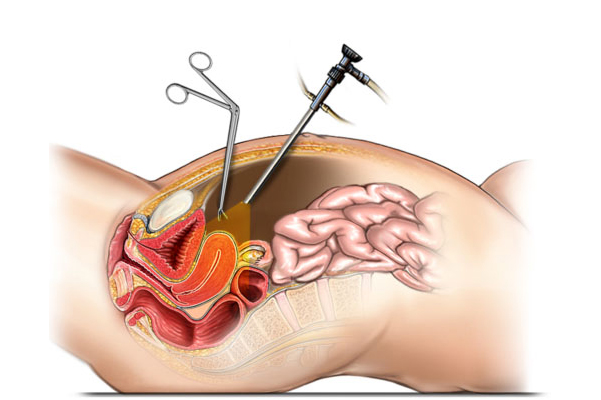

Laparoscopic gynecological surgery is a minimally invasive approach that allows the surgeon to operate without making a large incision. A thin, lighted tube with a camera on the end, known as a laparoscope, is inserted into the abdomen through a small incision. The camera sends images of the inside of the body to a TV monitor in the operating room, allowing the surgeon to see and operate on the pelvic organs without having to use a long incision.
Other small incisions may be made in the abdomen to insert very fine specialized surgical instruments.
Benefits of laparoscopic gynecological surgery can include less pain compared to open abdominal surgery, fewer complications, less scarring, shorter hospital stays, and faster recovery. Many patients go home the same day (outpatient surgery) or the next morning.
Laparoscopic surgery can be used to treat a variety of gynecologic conditions that previously required large incisions, including endometriosis, fibroids, ovarian cysts, ectopic pregnancy, sterilization, pelvic problems such as urinary incontinence and pelvic support problems such as uterine prolapse. It can also be used for a variety of procedures, including a laparoscopic hysterectomy and a laparoscopically assisted vaginal hysterectomy.
About gynaecological laparoscopy
Gynaecological laparoscopy is used to find out what’s causing certain symptoms you may have, as well as to treat several different conditions. These include:
diagnosing and treatingendometriosis – this is where cells like those that line your womb are found in other parts of your body.
removing scar tissue (adhesions) – scars can develop after infections such as pelvic inflammatory disease or because of endometriosis
treating an ectopic pregnancy – this is where a fertilised egg starts to develop outside your womb
performing a sterilisation, which means closing your fallopian tubes so that you can no longer get pregnant
removing an ovarian cyst
removing your womb (hysterectomy) or ovaries (oophorectomy)
treating fibroids
investigating whether you may have cancer or whether cancer has spread.
A specialist doctor called a gynaecologist might take a small sample of tissue (biopsy) during the laparoscopy. This will be sent to a laboratory for testing to see if you have cancer. A biopsy can also help to diagnose endometriosis.
You may also have a gynaecological laparoscopy to find out the cause of any ongoing tummy pain. If you’re trying for a baby but having difficulty, laparoscopy can be used to look for reasons why you might not be getting pregnant.
What to expect afterwards
You’ll need to rest until the effects of the anaesthetic have passed. You might have some discomfort as the anaesthetic wears off but you’ll be offered pain relief.
You’ll usually be able to go home after a few hours when you feel ready. Ask family or a friend to take you home, and ask them to stay with you for a day or so while the anaesthetic wears off.
After having a general anaesthetic , You might find that you’re not so coordinated or that it’s difficult to think clearly. This should pass within 24 hours. In the meantime, don’t drive, drink alcohol, operate machinery or sign anything important.
You may have some bleeding from your vagina for the first day or two. You can use sanitary pads until the bleeding stops. If you have bleeding that’s similar to a heavy period, give your hospital a call to seek medical advice.
Your nurse will give you advice about caring for your wounds, hygiene and bathing. You may be given a date for a follow-up appointment.
If you have dissolvable stitches or glue on your wounds, these will dissolve on their own. If you have non-dissolvable stitches, you’ll need to have them taken out, usually after about five to seven days.
